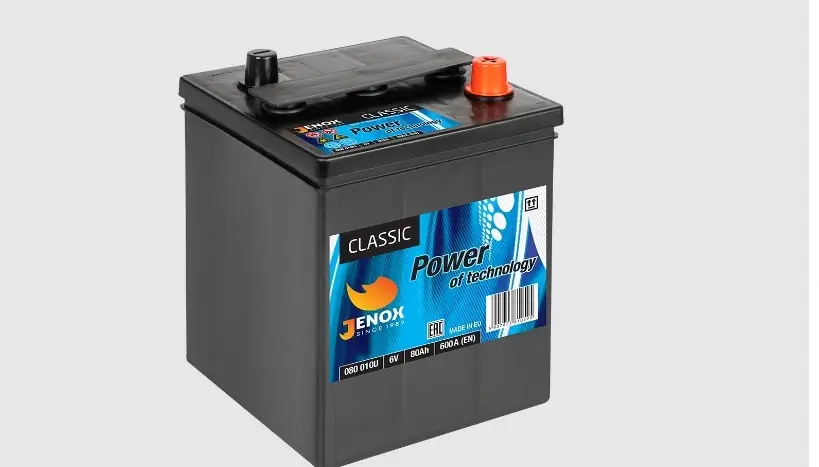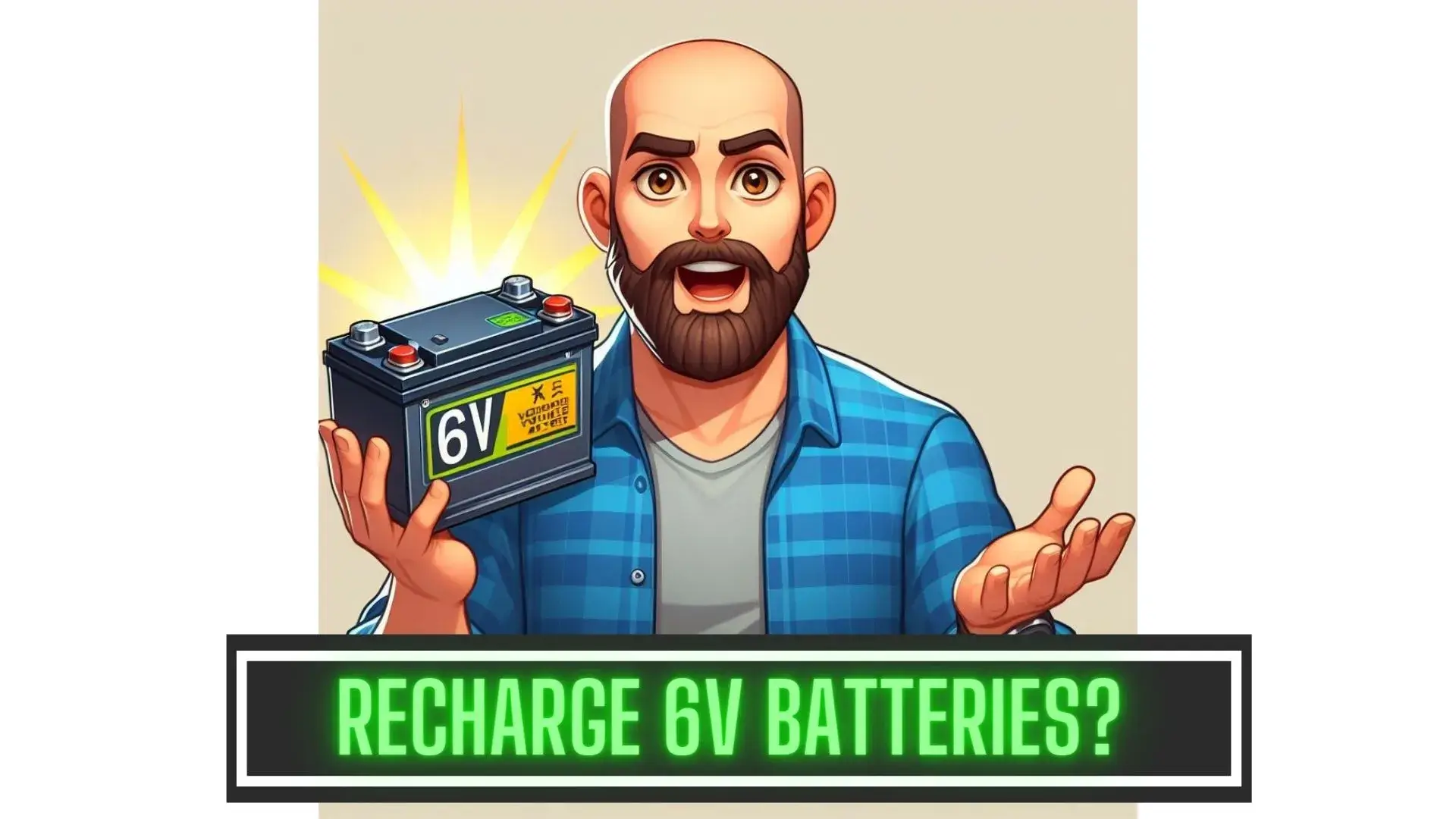Are 6-volt Batteries Rechargeable? It’s a common question, and we have the answer. Read on to find out all the information you NEED to know!
You probably have some 6-volt batteries in your home, right? Maybe you use them for your portable devices, backup power, or DIY projects. But do you know if they are rechargeable or not?
The answer is yes, but not all of them. There are various kinds of 6-volt batteries; some are designed to be recharged, while others are not. And if you mix them up, you could waste your money or even risk your safety. That’s why I created this quick guide. It shows you which 6-volt batteries are rechargeable and how to recharge them the right way.
Now, let’s see if we can recharge your batteries.
| Rechargeable | Non-Rechargeable | |
|---|---|---|
| Can Be Recharged | Yes, it can be recharged hundreds of times if properly maintained | No, designed for single-use |
| Common Types | Lead-acid: durable, cost-effective, used in vehicles and equipment Nickel-cadmium (NiCd): moderate energy density, prone to memory effect Nickel-metal hydride (NiMH): no memory effect, less toxic than NiCd | Alkaline: common in household devices, not reusable Zinc-carbon: inexpensive, lower energy density than alkaline |
| Composition | Lead-acid: Lead dioxide positive electrode, sponge lead negative electrode, sulfuric acid electrolyte NiCd/NiMH: Nickel oxide hydroxide positive electrode, cadmium or metal hydride negative electrode, potassium hydroxide electrolyte | Alkaline: Zinc negative electrode, manganese dioxide positive electrode, potassium hydroxide electrolyte Zinc-carbon: Zinc casing negative electrode, carbon rod positive electrode, ammonium chloride or zinc chloride electrolyte |
| Example Uses | Lead-acid: Golf carts, electric wheelchairs, solar power systems NiCd/NiMH: Portable electronics, toys, battery packs | Alkaline: Flashlights, remote controls, clocks, smoke detectors Zinc-carbon: Low-drain electronics, toys, novelty items |
| Cost | Higher initial purchase cost, lower long-term cost from reusability | Lower initial purchase cost, higher long-term cost from single-use |
| Voltage | Usually 6V nominal, fully charged up to 6.3V | Start at 6V when fresh, drops gradually as the battery is used |
| Self-Discharge | 15% per month (lead-acid), 20% per month (NiCd/NiMH) | 5% per year (alkaline) |
Table of Contents
Are 6-volt Batteries Rechargeable?
As an enthusiast, I often get asked if 6-volt batteries can be recharged. The answer is yes, but it depends on the type of battery.
There are two categories of 6-volt batteries: rechargeable and non-rechargeable. Non-rechargeable batteries, also known as primary batteries, are designed to be used once. Then, they are disposed of. They cannot be recharged, and attempting to do so can be dangerous.
Rechargeable batteries, also known as secondary batteries, are designed to be recharged and used multiple times. Rechargeable 6-volt batteries are used in golf carts, wheelchairs, and other electric vehicles.
If you have a rechargeable 6-volt battery, it is important to use the correct charger. Using the wrong charger can damage the battery or even cause it to explode. Make sure to read the manufacturer’s instructions. Use a charger that is designed for your specific battery.
It is also important to note that rechargeable batteries have a limited lifespan. Over time, they will start to lose their ability to hold a charge and will need to be replaced. If you notice that your 6-volt battery is not holding a charge as well as it used to, it may be time to replace it.
Factors Affecting Rechargeability
Let’s look at which types of batteries are rechargeable and why.
Battery Type
The first factor that affects the rechargeability of 6-volt batteries is the type. Some 6-volt batteries are designed to be rechargeable, while others are not. For example, lead-acid batteries are commonly used in cars and other vehicles. They are rechargeable. On the other hand, alkaline batteries are not rechargeable and must be disposed of after use.
Usage
The second factor that affects the rechargeability of 6-volt batteries is usage. The more a battery is used, the more it will need to be recharged. If a battery is used a lot, it will need recharging more than a battery that is used infrequently. Additionally, the amount of power that a battery can hold will decrease over time. This can impact its rechargeability.
Maintenance
The third factor that affects the rechargeability of 6-volt batteries is maintenance. Proper maintenance can help extend a battery’s life and improve its rechargeability. For example, keeping the battery clean and free of dirt and debris can help prevent corrosion. Corrosion can impact the battery’s ability to hold a charge. Additionally, storing the battery in a cool, dry place can help prevent damage. It can also prolong its life.
Use Cases for 6 Volt Batteries
So, what are the use cases of 6-Volt batteries? Glad you asked!
6-volt batteries have been around for a long time. They stay popular due to their versatility and reliability as a battery technology. Here are some of the most common use cases for 6-volt batteries.

Golf Carts and Other Electrically-Powered Vehicles
6-volt batteries are often used in electric vehicles. Examples include golf carts, scooters, and electric wheelchairs. These vehicles can be powered by a single 12-volt battery or, more often, several 6-volt batteries wired in series to make 12, 24, 36, or 48-volt stacks.
Using multiple 6-volt batteries is often a better choice. Each 6-volt cell has a wide internal surface area, which means that it can hold a larger amp capacity. This makes 6-volt batteries ideal for powering electric vehicles. Electric vehicles need a lot of energy to operate.
Emergency Lighting and Backup Power
Remember I said that electric vehicles weren’t the only use case for 6-volt batteries?
Well, they are also used in Emergency Lighting and Backup Power systems.
6-volters are often used with solar panels or other renewable energy sources. They provide reliable, long-lasting power during a power outage. They are also used in camping lanterns and other portable lighting devices. They can provide a lot of power in a small, lightweight package.
Roadworks and Construction
6-volt batteries are also commonly used in roadworks and construction projects. They often power traffic signals and other lighting systems. Because here’s the thing: They provide a lot of power for an extended period. They are ideal for use in remote locations or areas with limited access to power.
Marine and RV Applications
6-volt batteries are often used in marine and RV applications. These batteries are designed to be rugged and reliable. They are ideal for use in harsh environments like the open sea or the desert. They are commonly used to power trolling motors and navigation lights on boats and RVs. They also power other essential systems.
Classic Motorcycles and Vintage Cars

6-volt batteries are often used in classic motorcycles and vintage cars. These vehicles, particularly those manufactured before the 1950s, were originally designed to run on 6-volt electrical systems. Restorers and enthusiasts often prefer to maintain the original 6-volt system to preserve the vehicle’s authenticity. The 6-volt batteries used in these applications are normally lead-acid batteries, which can be recharged.
Toys and Ride-On Cars
6-volt batteries are commonly used in children’s toys, particularly ride-on cars. These toys are designed for younger children, typically aged 1-3 years, and the 6-volt battery provides a safe and gentle ride. The lower power rating is perfect for children at this age, which means they shouldn’t be too overwhelmed by the amount of power and speed available.
Trail Cameras
Finally, trail cameras, used by wildlife enthusiasts and researchers, often operate on 6-volt batteries. These cameras need to be left in the field for extended periods, and the 6-volt batteries provide a reliable power source. However, it’s important to note that rechargeable batteries are not typically recommended for these devices due to their lesser charge retention.
6-Volt battery applications that should AVOID rechargeables
Now, you might think that using rechargeables in all 6-volt battery applications is a no-brainer. After all, they’re better for the environment and more cost-effective, right?
Well, that’s true, but there are some devices when alkaline batteries are more suitable. Let’s look at some popular ones and why.
Devices with specific voltage requirements
Some brands of DAB radios, where four or six batteries are used in series, may not perform as well with rechargeable batteries due to the voltage difference between NiMH rechargeable batteries and standard alkaline batteries.
Devices with specific voltage requirements may not function properly or even be damaged if a higher-voltage rechargeable battery is used.
Devices Relying on Battery’s Internal Resistance
Some circuits might rely on the battery’s internal resistance for proper functioning. Using a rechargeable battery with a different internal resistance could affect the device’s performance.
Low-Drain Devices
Devices like smoke detectors, clocks, and remotes, or devices you rarely use but always want at the ready, like a weather radio or a flashlight, should always use alkalines. The higher self-discharge rate of rechargeables is a factor that counts against using rechargeables for these devices.
Understanding 6 Volt Batteries
I have used a lot of different types of batteries over the years. I have come across 6-volt batteries in various applications. Let’s take a closer look.
Components of a 6 Volt Battery
A 6-volt battery is typically composed of the following components:
- The positive and negative electrodes are the terminals of the battery. They are connected to the device or circuit that is being powered.
- An electrolyte is a chemical solution. It facilitates the flow of electrons between the positive and negative electrodes.
- A separator is a porous material. It separates the positive and negative electrodes. It allows the electrolyte to flow between them.
- Container: This is the outer casing that holds all the components of the battery together.
How 6-Volt Batteries Work
If you got this far, then good on you! Let’s look at the mechanics of 6-volt batteries.
6-volt batteries operate in much the same way as other voltage batteries. Here’s a quick explainer:
A 6-volt battery, like other batteries, operates on the principle of electrochemical reactions. When the battery is connected to a device or circuit, a chemical reaction occurs within the battery. This reaction involves the movement of electrons from the negative electrode (anode) to the positive electrode (cathode), creating an electric current that powers our devices.
The electrolyte and the electrodes are vital for this chemical reaction. In a lead-acid battery, the positive electrode is composed of lead dioxide (PbO2), while the negative electrode is made of sponge lead (Pb). The electrolyte is a solution of sulfuric acid (H2SO4).
When the battery is fully discharged, the lead dioxide (PbO2) on the positive electrode and the sponge lead (Pb) on the negative electrode both get converted to lead sulfate (PbSO4). At the same time, the sulfuric acid (H2SO4) in the electrolyte gets converted to water (H2O).
When the battery is being charged, this process is reversed: the lead sulfate (PbSO4) on both electrodes gets converted back to lead dioxide (PbO2) on the positive electrode and sponge lead (Pb) on the negative electrode, and the water (H2O) in the electrolyte gets converted back to sulfuric acid (H2SO4).
This charge and discharge cycle can be repeated over and over so the battery can provide power when needed. Neat, huh?
But bear in mind that, over time, the efficiency of this cycle decreases, which is why batteries eventually need to be replaced.
Before You Go …
You’ve learned how to recharge your 6-volt batteries, but what about your 12-volt ones? Do you know how to avoid overcharging them and damaging them permanently?
Overcharging a 12-volt battery can reduce performance and shorten its lifespan. It can also create fire hazards.
That’s why you need to read our next post: “Can You Overcharge a 12 Volt Battery”. Don’t risk ruining your battery; read my post for more information.
Frequently Asked Questions
Here’s the FAQs
Can 6-volt batteries be recharged?
Yes, 6-volt batteries can be recharged. It is important to note that not all 6-volt batteries are rechargeable. Check the label or specifications of your battery. Make sure it’s rechargeable before attempting to recharge it.
What is the best way to recharge a 6-volt battery?
Use a charger specifically designed for 6-volt batteries to recharge a 6-volt battery. Follow the manufacturer’s instructions and safety precautions when using a battery charger. Overcharging or undercharging a battery can damage it and reduce its lifespan.
How long does it take to charge a 6-volt rechargeable battery?
The charging time for a 6-volt rechargeable battery varies. It depends on the type of battery and the charger being used. Generally, it can take anywhere from a few hours to overnight to fully charge a 6-volt battery. Referring to the manufacturer’s instructions for specific charging times is important.
What is the lifespan of a 6-volt rechargeable battery?
The lifespan of a 6-volt rechargeable battery depends on several factors. These include usage, charging habits, and storage conditions. With care and maintenance, a 6-volt rechargeable battery can last for several years.
Which type of 6-volt rechargeable battery is best for toy cars?
The best type of 6-volt rechargeable battery for toy cars is a sealed lead-acid (SLA) battery. SLA batteries are durable, reliable, and consistent for extended periods of time. They are also relatively easy to maintain and can be recharged multiple times.
Where can I find a 6-volt battery charger?
You can find 6-volt battery chargers at most electronics, hardware, and online stores. It is important to choose a charger that is compatible with your specific type of battery. Also, follow the manufacturer’s instructions for use.
Related Posts
- What Causes a Battery Charger to Explode: The Shocking Reality you NEED to know
- Is It Safe to Leave a Jump Starter in Your Car? A Quick Guide for Drivers
- What is More Important: Volts or Amps for Charging? Don’t Let Slow Charging Hold You Back
- Do Solar Panels Work At Night And On Cloudy Days? We Reveal all in our Important Helpful Guide


